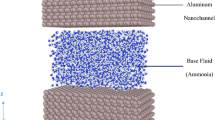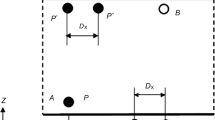Abstract
Generally, the addition of nanoparticles to a fluid significantly increases the thermal conductivity of structures. In the present study, the effect of nanoparticle volume ratio and initial temperature on ammonia/copper nano-refrigerant’s thermal behavior in an external electric field in an aluminum nanochannel was studied by molecular dynamics simulations. To study the thermal behavior of the structures, quantities such as particle phase-changed rates (condensation process), phase change duration, and thermal conductivity were investigated. Results show that with the addition of 5% copper to the base fluid, the rate of the phase-changed particles increases from 53 to 71% during 2.40 ns. Also, increasing the volume ratio of nanoparticles up to 5% leads to an increase in thermal conductivity from 0.76 to 0.86 W/mK. On the other hand, increasing the initial temperature up to 350 K reduces the phase-changed particles’ rate from 53 to 49% during 2.9 ns. The initial temperature increases from 300 to 350 K, and the thermal conductivity decreases from 0.76 to 0.73 W/mK. The results of this simulation are expected to improve the thermal performance of different nano-refrigerants.









Similar content being viewed by others
Data availability
N/A.
Code availability
N/A.
References
Zhou Y, Wu J, Wang R, Shiochi S (2007) Energy simulation in the variable refrigerant flow air-conditioning system under cooling conditions. Energy and Buildings 39(2):212–220
Messineo A, Panno D (2012) Performance evaluation of cascade refrigeration systems using different refrigerants. Int J Air-Cond Refrig 20(03):1250010
Apostol V, Popescu G, Pop H, Feidt M, and Popescu T (2008) Thermodynamic analysis of new eco-refrigerants ammonia and dimethylether blends, p 75–81
Yu W, and Xie H (2012) “A review on nanofluids: preparation, stability mechanisms, and applications,” J Nanomater 2012:435873
Yang L, Jiang W, Ji W, Mahian O, Bazri S, Sadri R, Badruddin IA, Wongwises S (2020) A review of heating/cooling processes using nanomaterials suspended in refrigerants and lubricants. Int J Heat Mass Transf 153:119611
Verma SK, Tiwari AK (2015) Progress of nanofluid application in solar collectors: a review. Energy Convers Manage 100:324–346
Ghalandari M, Maleki A, Haghighi A, Shadloo MS, Nazari MA, Tlili I (2020) Applications of nanofluids containing carbon nanotubes in solar energy systems: a review. J Mol Liq 313:113476
Chu YM et al (2022) Model ‐ based comparative study of magnetohydrodynamics unsteady hybrid nanofluid flow between two infinite parallel plates with particle shape effects. Math Methods Appl Sci. https://doi.org/10.1002/mma.8234
Chu YM, et al (2021) Enhancement in thermal energy and solute particles using hybrid nanoparticles by engaging activation energy and chemical reaction over a parabolic surface via finite element approach. Fractal and Fractional 5(3):119
Nazeer M et al (2022) Theoretical study of MHD electro-osmotically flow of third-grade fluid in micro channel. Appl Math Comput 420:126868
Motlagh MB, Kalteh M (2020) Simulating the convective heat transfer of nanofluid Poiseuille flow in a nanochannel by molecular dynamics method. Int Commun Heat Mass Transfer 111:104478
Afrand M, Toghraie D, Ruhani B (2016) Effects of temperature and nanoparticles concentration on rheological behavior of Fe3O4–Ag/EG hybrid nanofluid: an experimental study. Exp Thermal Fluid Sci 77:38–44
Sheikholeslami M, Rezaeianjouybari B, Darzi M, Shafee A, Li Z, Nguyen TK (2019) Application of nano-refrigerant for boiling heat transfer enhancement employing an experimental study. Int J Heat Mass Transf 141:974–980
Peng H, Ding G, Hu H, Jiang W (2011) Effect of nanoparticle size on nucleate pool boiling heat transfer of refrigerant/oil mixture with nanoparticles. Int J Heat Mass Transf 54(9–10):1839–1850
Sun B, Yang D (2014) Flow boiling heat transfer characteristics of nano-refrigerants in a horizontal tube. Int J Refrig 38:206–214
Rapaport DC (2004) The art of molecular dynamics simulation: Cambridge University Press; 2nd edition (April 19, 2004)
Shamsetdinov F, Zaripov Z, Abdulagatov IM, Huber ML, Gumerov F, Gabitov F, Kazakov AF (2013) Experimental study of the thermal conductivity of ammonia+ water refrigerant mixtures at temperatures from 278 K to 356 K and at pressures up to 20 MPa. Int J Refrig 36(4):1347–1368
Toghraie D, Hekmatifar M, Salehipour Y, Afrand M (2019) Molecular dynamics simulation of Couette and Poiseuille water-copper nanofluid flows in rough and smooth nanochannels with different roughness configurations. Chem Phys 527:110505
Rappé AK, Casewit CJ, Colwell K, Goddard WA III, Skiff WM (1992) UFF, a full periodic table force field for molecular mechanics and molecular dynamics simulations. J Am Chem Soc 114(25):10024–10035
Mayo SL, Olafson BD, Goddard WA (1990) DREIDING: a generic force field for molecular simulations. J Phys Chem 94(26):8897–8909
Frankel D, Smit B (2002) “Molecular simulation: from algorithm to applications,” Academic Press, second edition edition. https://doi.org/10.1063/1.881812
Hanwell MD, Curtis DE, Lonie DC, Vandermeersch T, Zurek E and Hutchison GR (2012) “Avogadro: an advanced semantic chemical editor, visualization, and analysis platform” J Cheminform 4:17. https://doi.org/10.1186/1758-2946-4-17
Martínez L, Andrade R, Birgin EG, Martínez JM (2009) Packmol: a package for building initial configurations for molecular dynamics simulations. J Comput Chem 30(13):2157–2164
Author information
Authors and Affiliations
Corresponding author
Ethics declarations
Conflict of interest
The authors declare no competing interests.
Additional information
Publisher's note
Springer Nature remains neutral with regard to jurisdictional claims in published maps and institutional affiliations.
Rights and permissions
About this article
Cite this article
Abed, H., Ali Fazilati, M., Toghraie, D. et al. Molecular dynamics study of the thermal behavior of ammonia refrigerant in the presence of copper nanoparticles at different volume ratios and initial temperatures. J Mol Model 28, 157 (2022). https://doi.org/10.1007/s00894-022-05156-1
Received:
Accepted:
Published:
DOI: https://doi.org/10.1007/s00894-022-05156-1




